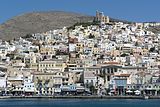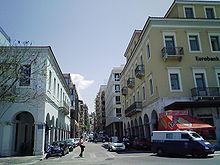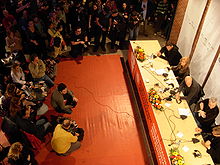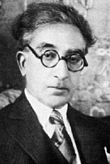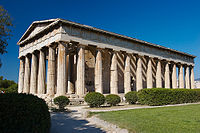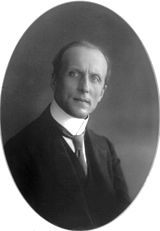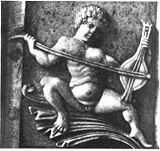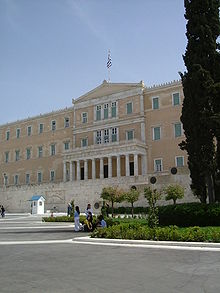- Culture of Greece
-
The culture of Greece has evolved over thousands of years, beginning in Mycenaean Greece, continuing most notably into Classical Greece, through the influence of the Roman Empire and its Greek Eastern successor the Byzantine Empire. Foreign occupiers such as the Ottoman Empire, medieval Latin kingdoms, the Venetian Republic, Genoese Republic, and British Empire have also left their influence on modern Greek culture, but historians credit the Greek war of independence with revitalising Greece and giving birth to a single entity of its multi-faceted culture.
Contents
Arts
Because of the ravages of time, only a minor assortment of ancient Greek art has survived - most frequently in the form of sculpture and architecture and minor arts, including coin design, pottery and gem engraving. Greece also has a rich history of contemporary art from the revolution onwards.
Architecture
Main article: Architecture of Ancient GreeceAncient Greek architecture is best known through its temples and theatres.
Main article: Byzantine architecture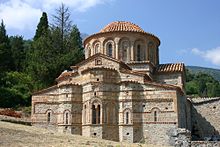 The Byzantine church of Agii Theodori, Mystras.
The Byzantine church of Agii Theodori, Mystras.
Byzantine architecture emphasized a Greek cross layout, the Byzantine capitol style of column (a mixture of Ionic and Corinthian capitols) and a central dome surrounded by several smaller domes.
Main article: Modern Greek architectureDuring the nineteenth century, the Neo-classical vocabulary was heavily used for both public and private building.[1]
For churches, Greece also experienced something of a Neo-Byzantine revival.
In the twentieth century, Greek architecture has followed international architectural trends. Important Greek and international architects have designed many buildings of Athens such as Dimitris Pikionis, Stamatios Kleanthis, Anastasios Metaxas, Ernst Ziller, Theophil Freiherr von Hansen, Patroklos Karantinos, Walter Gropius, Eero Saarinen and Mario Botta. Several new buildings were also constructed by Santiago Calatrava for the 2004 Athens Olympics, while Bernard Tschumi designed the New Acropolis Museum.
Modern Greek art
Main article: Modern Greek art Nikolaos Gyzis (1842-1901), painter from Tinos. The island of Tinos has a significal contribution to modern Greek painting and sculpture.
Nikolaos Gyzis (1842-1901), painter from Tinos. The island of Tinos has a significal contribution to modern Greek painting and sculpture.
Modern Greek art is the term used to describe Greek art during the period between the emergence of the new independent Greek state and the 20th century. Mainland Greece being under the Ottoman rule for almost 4 centuries has naturally missed the Renaissance and the artistic movements that followed, in Western Europe. However, Greek islands such as Crete, and the Ionian islands in particular were for large periods under Venetian or other European powers' rule and thus, were able to assimilate better the radical artistic changes that were occurring in Europe during the 14th-18th century. The Cretan School and in particular the Heptanese School of art are two typical examples of artistic movements in Greece that followed parallel routes to Western Europe.[2] There were therefore different artistic trends in the emerging Greek society. It is reasonable to claim that it was the particular socioeconomic conditions of Greece, the large Greek diaspora across Europe, the new Greek social elite and the artistic influences of mainly Germany and France that shaped to a large extend what we call Art in Modern Greece.
Cinema
Main article: Greek cinemaCinema first appeared in Greece in 1896 but the first actual theatre was built later in 1907. The first production began in 1914 as the Asty Film Company was founded and the production of long films begun. Golfo (Γκόλφω), a well known traditional love story, is the first Greek long movie, although there were several minor productions such as newscasts before this.
The 1950s and early 1960s are considered by many as the Greek Golden age of Cinema. Directors and actors of this era were recognized as important historical figures in Greece and some gained international acclaim. M. Cacoyannis, Alekos Sakellarios, Nikos Tsiforos, Ellie Lambeti, Dinos Iliopoulos, Irene Papas, etc. More than sixty films per year were made, with the majority having film noir elements . Notable films were Η κάλπικη λίρα (1955 directed by G. Tzavelas), Πικρό Ψωμί (1951, directed by G. Grigoriou), Δράκος (O Drakos, 1956, directed by N. Koundouros), Stella (1955, directed by M. Cacoyannis and written by I. Kampanellis). M. Cacoyannis also directed Zorba the Greek with Anthony Quinn which received Best Director, Best Adapted Screenplay and Best Film nominations. Finos Film also contributed to this period with movies such as Λατέρνα, Φτώχεια και Φιλότιμο, Η Θεία από το Σικάγο, and Το ξύλο βγήκε από τον Παράδεισο.
There were also internationally renowned filmmakers in the Greek diaspora such as the Greek-American Elia Kazan.
Language
Main article: Greek languageThe Greek language is the official language of the Hellenic Republic and has a total of 15 million speakers worldwide; it is an Indo-European language. It is particularly remarkable in the depth of its continuity, beginning with the pre-historic Mycenaean Greek and the Linear B script, and maybe the Linear A script associated with Minoan civilization, though Linear A is still undeciphered. Greek language is clearly detected in the Mycenaean language and the Cypriot syllabary, and eventually the dialects of Ancient Greek, of which Attic Greek bears the most resemblance to Modern Greek. The history of the language spans over 3400 years of written records.
Greek has had enormous impact on other languages both directly on the Romance languages, and indirectly through its influence on the emerging Latin language during the early days of Rome. Signs of this influence, and its many developments, can be seen throughout the family of Western European languages.
Internet and "Greeklish"
More recently, the rise of internet-based communication services as well as cell phones have caused a distinctive form of Greek written partially, and sometimes fully in Latin characters to emerge; this is known as Greeklish, a form that has spread across the Greek diaspora and even to the two countries with majority Greek population, Cyprus and Greece.
Katharevousa
Main article: KatharevousaKatharévousa is a purified form of the Greek Language midway between modern and ancient forms set in train during the early nineteenth century by Greek intellectual and revolutionary leader Adamantios Korais, intended to return the Greek language closer to its ancient form. Its influence, in recent years, evolved toward a more formal role, and it came to be used primarily for official purposes such as diplomacy, politics, and other forms of official documentation. It has nevertheless had significant effects on the Greek language as it is still written and spoken today, and both vocabulary and grammatical and syntactical forms have re-entered Modern Greek via Katharevousa.
Dialects

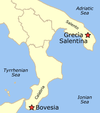 Distribution of Greek dialects during the late Byzantine times (left) and areas in South Italy where Griko language is still spoken (right).
Distribution of Greek dialects during the late Byzantine times (left) and areas in South Italy where Griko language is still spoken (right).There are a variety of dialects of the Greek language; the most notable include Cappadocian, Cretan Greek, Cypriot Greek, Pontic Greek, the Griko language spoken in Southern Italy, and Tsakonian, still spoken in the modern prefecture of Arcadia and widely noted as a surviving regional dialect of Doric Greek.
Literature
Main article: Greek literatureGreece has a remarkably rich and resilient literary tradition, extending over 2800 years and through several eras. The Classical era is that most commonly associated with Greek Literature, beginning in 800 BCE and maintaining its influence through to the beginnings of Byzantine period, whereafter the influence of Christianity began to spawn a new development of the Greek written word. The many elements of a millennia-old tradition are reflected in Modern Greek literature, including the works of the Nobel laureates Odysseus Elytis and George Seferis.
Classical Greece
The first recorded works in the western literary tradition are the epic poems of Homer and Hesiod. Early Greek lyric poetry, as represented by poets such as Sappho and Pindar, was responsible for defining the lyric genre as it is understood today in western literature. Aesop wrote his Fables in the 6th century BC. These innovations were to have a profound influence not only on Roman poets, most notably Virgil in his epic poem on the founding of Rome, The Aeneid, but one that flourished throughout Europe.
Classical Greece is also judged the birthplace of theatre. Aeschylus introduced the ideas of dialogue and interacting characters to playwriting and in doing so, he effectively invented "drama": his Oresteia trilogy of plays is judged his crowning achievement. Other refiners of playwriting were Sophocles and Euripides. Aristophanes, a comic playwright, defined and shaped the idea of comedy as a theatrical form.
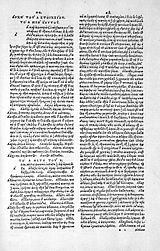 A page from a 16th-century edition of the 10th century Byzantine encyclopaedia of the ancient Mediterranean world, the Suda.
A page from a 16th-century edition of the 10th century Byzantine encyclopaedia of the ancient Mediterranean world, the Suda.
Herodotus and Thucydides are often attributed with developing the modern study of history into a field worthy of philosophical, literary, and scientific pursuit. Polybius first introduced into study the concept of military history.
Philosophy entered literature in the dialogues of Plato, while his pupil Aristotle, in his work the Poetics, formulated the first set criteria for literary criticism. Both these literary figures, in the context of the broader contributions of Greek philosophy in the Classical and Hellenistic eras, were to give rise to idea of Political Science, the study of political evolution and the critique of governmental systems.
Byzantine Greece
Main article: Byzantine LiteratureThe growth of Christianity throughout the Greco-Roman world in the 4th, 5th and 6th centuries, together with the Hellenization of the Byzantine Empire of the period, would lead to the formation of a unique literary form, combining Christian, Greek, Roman and Oriental (such as the Persian Empire) influences. In its turn, this would promote developments such as Cretan poetry, the growth of poetic satire in the Greek East, and the several pre-eminent historians of the period.
Modern Greece
Modern Greek Literature was born out of the Greek Revolution of 1821 and the subsequent independence of Greece in 1831, and as such, Greek literature of the period is heavily influenced by revolutionary themes, although the impact of the Greek literature of the Enlightenment could also be highlighted, as well as the influence of the Byzantine Empire's Acritic songs and romance.
Moving into the twentieth century, the modern Greek literary tradition spans the work of Constantine P. Cavafy, considered a key figure of twentieth century poetry, Giorgos Seferis (whose works and poems aimed to fuse the literature of Ancient and Modern Greece) and Odysseas Elytis, both of whom won the Nobel Prize for Literature. Nikos Kazantzakis is also considered a dominant figure, with works such as The Last Temptation of Christ and The Greek Passion receiving international recognition.
Religion
Main articles: Religion in Greece, Eastern Orthodox Church
Classical Greece
Classical Athens may be suggested to have heralded some of the same religious ideas that would later be promoted by Christianity, such as Aristotle's invocation of a perfect God, and Heraclitus' Logos. Plato considered there were rewards for the virtuous in the heavens and punishment for the wicked under the earth; the soul was valued more highly than the material body, and the material world was understood to be imperfect and not fully real (illustrated in Socrates's allegory of the cave).
Hellenistic Greece
Alexander's conquests spread classical concepts about the divine, the afterlife, and much else across the eastern Mediterranean area. Jews and early Christians alike adopted the name "hades" when writing about "sheol" in Greek. Greco-Buddhism was the cultural syncretism between Hellenistic culture and Buddhism, which developed in the Indo-Greek Kingdoms. By the advent of Christianity, the four original patriarchates beyond Rome used Greek as their church language.
Modern Greece
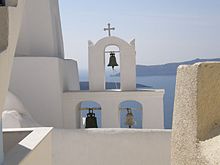 Agios Minas, Santorini.
Agios Minas, Santorini.
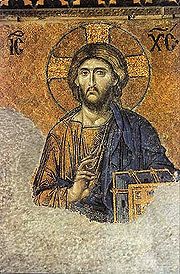 Example of Greek Orthodox visual hagiography.
Example of Greek Orthodox visual hagiography.
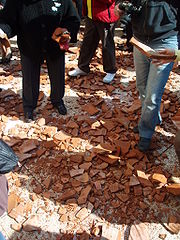 Shards of pottery vases on the street, after being thrown from the windows of nearby houses. A Holy Saturday tradition in Corfu.
Shards of pottery vases on the street, after being thrown from the windows of nearby houses. A Holy Saturday tradition in Corfu.
The Greek Orthodox Church, largely because of the importance of Byzantium in Greek history, as well as its role in the revolution, is a major institution in modern Greece. Its roles in society and larger role in overarching Greek culture are very important; a number of Greeks attend Church at least once a month or more and the Orthodox Easter holiday holds special significance.
The Church of Greece also retains limited political influence through the fact the Greek constitution does not have an explicit separation of Church and State; a debate suggested by more conservative elements of the church in the early 2000s about identification cards and whether religious affiliation might be added to them highlights the friction between state and church on some issues; the proposal unsurprisingly was not accepted. A widely publicised set of corruption scandals in 2004 implicating a small group of senior churchmen also increased national debate on introducing a greater transparency to the church-state relationship.
Greek Orthodox Churches dot both the villages and towns of Greece and come in a variety of architectural forms, from older Byzantine churches, to more modern white brick churches, to newer cathedral-like structures with evident Byzantine influence. Greece (as well as Cyprus), also polled as, ostensibly, one of the most religious countries in Europe, according to Eurostat; however, while the church has wide respect as a moral and cultural institution, a contrast in religious belief with Protestant northern Europe is more obvious than one with Catholic Mediterranean Europe.
Greece also has a significant minority of Muslims in Eastern Thrace (numbering around 100-150,000), with their places of worship guaranteed since the 1923 Treaty of Lausanne. The Greek state has fully approved the construction a main mosque for the more recent Muslim community of Athens under the freedom of religion provisions of the Greek constitution.
Philosophy, science and mathematics
The Greek world is widely regarded as having given birth to scientific thought by means of observation, thought, and development of a theory without the intervention of a supernatural force. Thales, Anaximander and Democritus were amongst those contributing significantly to the establishment of this tradition. It is also, and perhaps more commonly in the western imagination, identified with the dawn of Western Philosophy, as well as a mapping out of the Natural Sciences. Greek developments of mathematics continued well up until the decline of the Byzantine Empire. In the modern era Greeks continue to contribute to the fields of Science, Mathematics and Philosophy.
Classical Greece
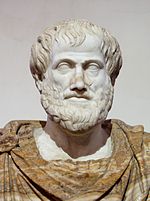 Marble bust of Aristotle.
Marble bust of Aristotle.
The tradition of philosophy in Ancient Greece accompanied its literary development. Greek learning had a profound influence on Western and Middle Eastern civilizations. The works of Socrates, Plato, Aristotle, and other Greek philosophers profoundly influenced Classical thought, the Islamic Golden Age, and the Renaissance.
In medicine, doctors still refer to the Hippocratic oath, instituted by Hippocrates, regarded as foremost in laying the foundations of medicine as a science. Galen built on Hippocrates' theory of the four humours, and his writings became the foundation of medicine in Europe and the Middle East for centuries. The physicians Herophilos and Paulus Aegineta were pioneers in the study of anatomy, while Pedanius Dioscorides wrote an extensive treatise on the practice of pharmacology.
The period of Classical Greece (from 800BC until the rise of Macedon, a Greek state in the north) is that most often associated with Greek advances in science. Thales of Miletus is regarded by many as the father of science; he was the first of the ancient philosophers to seek to explain the physical world in terms of natural rather than supernatural causes. Pythagoras was a mathematician often described as the "father of numbers"; it is believed that he had the pioneering insight into the numerical ratios that determine the musical scale, and the Pythagorean theorem is commonly attributed to him. Diophantus of Alexandria, in turn, was the "father of algebra". Many parts of modern geometry are based on the work of Euclid, while Eratosthenes was one of the first scientific geographers, calculating the circumference of the earth and conceiving the first maps based on scientific principles.
The Hellenistic period, following Alexander's conquests, continued and built upon this knowledge. Hipparchus is considered the pre-eminent astronomical observer of the ancient world, and was probably the first to develop an accurate method for the prediction of solar eclipse, while Aristarchus of Samos was the first known astronomer to propose a heliocentric model of the solar system, though the geocentric model of Ptolemy was more commonly accepted until the seventeenth century. Ptolemy also contributed substantially to cartography and to the science of optics. For his part Archimedes was the first to calculate the value of π and a geometric series, and also the earliest known mathematical physicist discovering the law of buoyancy, as well as conceiving the irrigation device known as Archimedes' screw.
Byzantine Greece
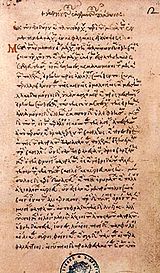 An original early 15th century manuscript in the hand of Georgios Gemistos Plethon.
An original early 15th century manuscript in the hand of Georgios Gemistos Plethon.
The Byzantine period remained largely a period of preservation in terms of classical Greco-Roman texts; there were, however, significant advances made in the fields of medicine and historical scholarship. Theological philosophy also remained an area of study, and there was, while not matching the achievements of preceding ages, a certain increase in the professionalism of study of these subjects, epitomized by the founding of the University of Constantinople.
Isidore of Miletus and Anthemius of Tralles, the architects of the famous Hagia Sophia in Constantinople, also contributed towards mathematical theories concerning architectural form, and the perceived mathematical harmony needed to create a multi-domed structure. These ideas were to prove a heavy influence on the Ottoman architect Mimar Sinan in his creation of the Blue Mosque, also in Constantinople. Tralles in particular produced several treatises on the Natural Sciences, as well as his other forays into mathematics such as Conic Sections.
The gradual migration of Greeks from Byzantium to the Italian city states following the decline of the Byzantine Empire, and the texts they brought with them combined with the academic positions they held, was a major factor in lighting the first sparks of the Italian Renaissance.
Modern Greece
Greeks continue to contribute to science and technology in the modern world. John Argyris, a Greek mathematician and engineer, is responsible for the invention of finite element analysis and the direct stiffness method, relative to physics. Mathematician Constantin Carathéodory worked in the fields of real analysis, the calculus of variations, and measure theory in the early 20th century. Biologist Fotis Kafatos pioneers in the field of molecular cloning and genomics. In medicine, Georgios Papanikolaou contributed heavily to the development of cancer screening with his Pap smear. The Greek car designer Alec Issigonis created the iconic Mini automobile, while the computer scientist Michael Dertouzos was amongst the pioneers of the internet. Nicolas Negroponte chairman of the Massachusetts Institute of Technology Media Lab is one of the founders of the program One Laptop Per Child, a non-profit organisation aiming to extend Internet access in developing countries.
Dance
Main article: Greek DancesGreece has a continuous history of native dances reaching from antiquity till the modern era. It began in the Mycenean period.
Classical Greece
Ancient Greeks believed that dancing was invented by the gods and therefore associated it with religious ceremony. They believed that the gods offered this gift to select mortals only, who in turn taught dancing to their fellow-men.
Periodic evidence in ancient texts indicates that dance was held in high regard, in particular for its educational qualities. Dance, along with writing, music, and physical exercise, was fundamental to the commenced in a circle and ended with the dancers facing one another. When not dancing in a circle the dancers held their hands high or waved them to left and right. They held cymbals (very like the zilia of today) or a kerchief in their hands, and their movements were emphasized by their long sleeves. As they danced, they sang, either set songs or extemporized ones, sometimes in unison, sometimes in refrain, repeating the verse sung by the lead dancer. The onlookers joined in, clapping the rhythm or singing. Professional singers, often the musicians themselves, composed lyrics to suit the occasion.
Byzantine instruments included the guitar, single, double or multiple flute, sistrum, timpani (drum), psaltirio, Sirigs, lyre, cymbals, keras and kanonaki.
Popular dances of this period included the Syrtos, Geranos, Mantilia , Saximos, Pyrichios, and Kordakas . Some of these dances have their origins in the ancient period and are still enacted in some form today.
Modern Greece
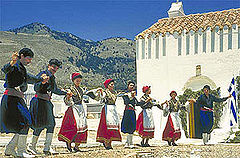 Dancers from Crete.
Dancers from Crete.
Greece is one of the few places in Europe where the day-to-day role of folk dance is sustained. Rather than functioning as a museum piece preserved only for performances and special events, it is a vivid expression of everyday life. Occasions for dance are usually weddings, family celebrations, and paneyeria (Patron Saints' name days). Dance has its place in ceremonial customs that are still preserved in Greek villages, such as dancing the bride during a wedding and dancing the trousseau of the bride during the wedding preparations. The carnival and Easter offer more opportunities for family gatherings and dancing. Greek taverns providing live entertainment often include folk dances in their program.
Regional characteristics have developed over the years because of variances in climatic conditions, land morphology, and people's social lives. In later years, wars, international pacts and consequent movement of populations, and even movements of civil servants around the country, intermingled traditions. People learned new dances, adapted them to their environment, and included them in their feasts. Kalamatianos and Tsamikos are considered Pan-Hellenic dances and are danced all over the world in diaspora communities. Others have also crossed boundaries and are known beyond the regions where they originated; these include theKaragouna from Thessaly, the Pentozalis from Crete, the Zonaradikos from Thrace, the Tik from Pontos, and the Balos from the Aegean Islands.
The avant-garde choreographer, director and dancer Dimitris Papaioannou was responsible for the critically successful Opening Ceremony of the 2004 Olympic Games, with a conception that reflected the classical influences on modern and experimental Greek dance forms.
Music
Main article: Music of GreeceGreece has a diverse and highly influential musical tradition, with ancient music influencing the Roman Empire, and Byzantine liturgical chants and secular music influencing the Renaissance. Modern Greek music combines these elements, as well as influences from the Middle East, to carry Greeks' interpretation of a wide range of musical forms.
Classical Greece
The history of music in Greece begins once more, as one might expect, with the music of ancient Greece, largely structured on the Lyre and other supporting string instruments of the era. Beyond the well-known structural legacies of the Pythagorean scale, and the related mathematical developments it upheld to define western classical music, relatively little is understood about the precise character of music during this period; we do know, however, that it left, as so often, a strong mark on the culture of Rome. What has been gleaned about the social role and character of ancient Greek music comes largely from pottery and other forms of Greek art.
Byzantine Greece
The Byzantine Music is also of major significance to the history and development of European music, as liturgical chants became the foundation and stepping stone for music of the Renaissance (see: Renaissance Music). It is also certain that Byzantine music included an extensive tradition of instrumental court music and dance; any other picture would be both incongruous with the historically and archaeologically documented opulence of the Eastern Roman Empire. There survive a few but explicit accounts of secular music. A characteristic example is the accounts of pneumatic organs, whose construction was further advanced in the eastern empire prior to their development in the west following the Renaissance.
Modern Greece
A range of domestically and internationally known composers and performers across the musical spectrum have found success in modern Greece, while traditional Greek music is noted as a mixture of influences from indigenous culture with those of west and east. A few Turkish and Ottoman elements can be most clearly heard in the traditional songs, dhimotiká, as well as the modern bluesy rembétika music. The best-known Greek musical instrument is the bouzouki. "Bouzouki" is a descriptive Turkish name, but the instrument itself is in fact of Greek rather than Turkish origin. It derives from the ancient Greek lute known as the pandoura, a kind of guitar, clearly visible in ancient statues, especially female figurines of the "Tanagraies" playing cord instruments.
Famous present-day Greek musicians include the central figure of 20th century European modernism Iannis Xenakis, a composer, architect and theorist. Maria Callas, Mikis Theodorakis, Dimitris Mitropoulos, Manos Hadjidakis, and Vangelis also lead twentieth-century Greek contributions, alongside Nikos Skalkottas, Demis Roussos, Nana Mouskouri, Yanni, Georges Moustaki and Giorgos Dalaras.
Education
Main article: Education in Greece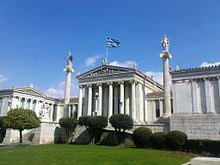 The Academy of Athens is Greece's national academy and the highest research establishment in the country.
The Academy of Athens is Greece's national academy and the highest research establishment in the country.
Education in Greece is compulsory for all children 6–15 years old; namely, it includes Primary (Dimotiko) and Lower Secondary (Gymnasio) Education. The school life of the students, however, can start from the age of 2.5 years (pre-school education) in institutions (private and public) called "Vrefonipiakoi Paidikoi Stathmi" (creches). In some Vrefonipiakoi Stathmoi there are also Nipiaka Tmimata (nursery classes) which operate along with the Nipiagogeia (kindergartens).
Post-compulsory Secondary Education, according to the reforms of 1997 and 2006, consists of two main school types: Genika Lykeia (General Upper Secondary Schools) and the Epaggelmatika Lykeia (Vocational Upper Secondary Schools), as well as the Epaggelmatikes Sxoles (Vocational Schools). Musical, Ecclesiastical and Physical Education Gymnasia and Lykeia are also in operation.
Post-compulsory Secondary Education also includes the Vocational Training Institutes (IEK), which provide formal but unclassified level of education. These Institutes are not classified as an educational level, because they accept both Gymnasio (lower secondary school) and Lykeio (upper secondary school) graduates according to the relevant specializations they provide. Public higher education is divided into Universities and Technological Education Institutes (TEI). Students are admitted to these Institutes according to their performance at national level examinations taking place at the second and third grade of Lykeio. Additionally, students are admitted to the Hellenic Open University upon the completion of the 22 year of age by drawing lots.
Nea Dimokratia (New Democracy), the Greek conservative right political party, has claimed that it will change the law so that private universities gain recognition. Without official recognition, students who have an EES degree are unable to work in the public sector. PASOK took some action after EU intervention, namely the creation of a special government agency which certifies the vocational status of certain EES degree holders. However, their academic status still remains a problem. The issue of full recognition is still an issue of debate among Greek politicians.
Politics
Main article: Politics of GreeceGreece is a Parliamentary Republic with a president assuming a more ceremonial role than in some other republics, and the Prime Minister chosen from the leader of the majority party in the parliament. Greece has a codified constitution and a written Bill of Rights embedded within it. The current Prime Minister is George Papandreou (junior).
The politics of the third Hellenic Republic have been dominated by two main political parties, the self proclaimed socialists of PASOK and the conservative New Democracy. Until recently[when?] PASOK had dominated the political scene, presiding over favourable growth rates economically but in the eyes of critics failing to deliver where unemployment and structural issues such as market liberalization were concerned.
New Democracy's election to government in 2004 has led to various initiatives to modernize the country, such as the education university scheme above as well as labour market liberalization. Politically there has been massive opposition to some of these moves owing to a large, well organized workers' movement in Greece, which distrusts the right wing administration and neo-liberal ideas. The population in general appears to accept many of the initiatives, reflected in governmental support; on the economic front many are so far warming to the reforms made by the administration, which have been largely rewarded with above average Eurozone growth rates. New Democracy were re-elected in September 2007.
A number of other smaller political parties exist. They include the third largest party (the Communist Party), which still commands large support from many rural working areas as well as some of the immigrant population in Greece, as well as the far-right Popular Orthodox Rally, with the latter, while commanding a mere three and a half per cent of votes, seeking to capitalise on opposition in some quarters regarding Turkey's EU accession and any tension in the Aegean. There is also a relatively small, but well organized anarchist movement, though its status in Greece has been somewhat exaggerated by media overseas.
The political process is energetically and openly participated in by the people of Greece, while public demonstrations are a continual feature of Athenian life; however, there have been criticisms of a governmental failure to sufficiently involve minorities in political debate and hence a sidelining of their opinions. In general, politics is regarded as an acceptable subject to broach on almost every social occasion, and Greeks are often very vocal about their support (or lack of it) for certain policy proposals, or political parties themselves - this is perhaps reflected in what many consider the rather sensationalist media on both sides of the political spectrum; although this is a feature of most European tabloids.
See also
- Art in modern Greece
- Center for the Greek language
- Cinema of Cyprus
- Cinema of Greece
- Education in Greece
- Greek cuisine
- Greek Orthodox Church
- Hellenic Foundation for Culture
- Holidays in Greece
- List of famous Greeks
- List of Greek dances
- List of Greek films
- List of universities in Greece
- OPA! Day
- Paideia
- Syncretism in Ancient Greece
References
Further reading
- Bruce Thornton, Greek Ways: How the Greeks Created Western Civilization, Encounter Books, 2002
- Hart, Laurie Kain (1999). "Culture, Civilization, and Demarcation at the Northwest Borders of Greece". American Ethnologist 26 (1): 196–220. doi:10.1525/ae.1999.26.1.196. ISSN 0094-0496.
- Simon Goldhill, Who Needs Greek?: Contests in the Cultural History of Hellenism, Cambridge University Press, 2002
- Victor Davis Hanson, John Heath, Who Killed Homer: The Demise of Classical Education and the Recovery of Greek Wisdom, Encounter Books, 2001
External links
- Hellenism Network - Greek Culture
- Sketch of the History of Greek Literature from the Earliest Times to the Reign of Alexander the Great by William Smith
- Anagnosis Books Modern Greek Culture Pages
- The Impact of Greek Culture on Normative Judaism from the Hellenistic Period through the Middle Ages c. 330 BCE- 1250 CE
- The Greek diet and its relationship to health
- Greece a cultural profile
 Greece topics
Greece topicsPeople 
History Greek countries and regions · Prehistory · Ancient Greece (Mycenaean period – Dark Age – Archaic period – Classical period – Hellenistic period – Roman period) · Byzantine era · Latin states · Ottoman period · War of Independence · Modern GreeceLaw Politics and
governmentGeography Regions · Climate · Mountains · Lakes · Rivers · Transport · Environmental issues · Islands · National Parks · List of earthquakes in GreeceEconomy Economic history · Debt crisis · Stock Exchange · Euro · Banks · Bank of Greece · Taxation · Shipping · TourismMilitary Demographics Demographic history · Social issues · Religion · Diaspora · Cities · Immigration · Minorities · CrimeCulture Other topics Flag · Coat of arms · National anthem · Evzones · Holidays · Name of Greece · International rankingsCulture of Europe Sovereign
states- Albania
- Andorra
- Armenia
- Austria
- Azerbaijan
- Belarus
- Belgium
- Bosnia and Herzegovina
- Bulgaria
- Croatia
- Cyprus
- Czech Republic
- Denmark
- Estonia
- Finland
- France
- Georgia
- Germany
- Greece
- Hungary
- Iceland
- Ireland
- Italy
- Kazakhstan
- Latvia
- Liechtenstein
- Lithuania
- Luxembourg
- Macedonia
- Malta
- Moldova
- Monaco
- Montenegro
- Netherlands
- Norway
- Poland
- Portugal
- Romania
- Russia
- San Marino
- Serbia
- Slovakia
- Slovenia
- Spain
- Sweden
- Switzerland
- Turkey
- Ukraine
- United Kingdom
- (England
- Northern Ireland
- Scotland
- Wales)
- Vatican City
States with limited
recognition- Abkhazia
- Kosovo
- Nagorno-Karabakh
- Northern Cyprus
- South Ossetia
- Transnistria
Dependencies
and other territories- Åland
- Faroe Islands
- Gibraltar
- Guernsey
- Jan Mayen
- Jersey
- Isle of Man
- Svalbard
Other entities - European Union
Categories:- Greek culture
Wikimedia Foundation. 2010.



